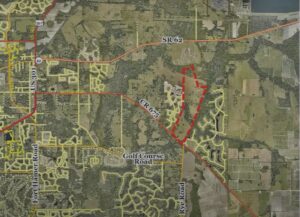Manatee County commissioners approve 1,100-home project on pasture land, beyond the urban development boundary.
By Johannes
Original Air Date: Dec. 8, 2023
Host: The seven Manatee County commissioners met yesterday to reconsider a nearly 500-acre, 1,100-home project on farmland near Parrish submitted by a national builder. Were they going back to the routine of approving massive projects east of the urban development boundary? Our news team watched the proceedings in downtown Bradenton.
Johannes Werner: To say it right away: The Manatee County Commission agreed, 7-0, to effectively move the urban development boundary at bit towards the east.

Map of Lazy C Ranch, near Parrish.
On Thursday at a land use meeting, it was Round 2 for national builder Pulte Homes and its Lazy C Ranch project. In June, the Manatee County commissioners surprised observers by rejecting the big development proposal. This was the first rejection for a major project in recent months, after their controversial approval of massive projects for local developers Carlos Beruff and SMR, the entity behind Lakewood Ranch. Those approvals have effectively pushed Manatee County’s urban development boundary east, and were accompanied by both protests and calls to move that boundary altogether.
The 495 acres of Lazy C Ranch straddle the Urban Development Boundary, the line east of which Manatee County does not offer roads and utilities. Pulte was asking the county to move the boundary to include the eastern segment of the property.
Kyle Grimes told commissioners that Pulte had addressed all three problematic issues that led to the first-round rejection. The Grimes Galvano lawyer, representing Pulte Homes, said that Point One was a matter of process. Technically, this was about a comprehensive map amendment and a rezone. This time, they separated both in the agenda. Next, they made sure Pulte committed to a limit of 1,100 homes and residential construction-only in the agreement, to prevent a possible next owner to ask for increased density again, without a comprehensive plan amendment. Thirdly, Pulte sat down with the developer of nearby Rye Ranch, to hash out an agreement over construction of a water main.
Kyle Grimes: So those are really the three main concerns that, we feel, were raised during the initial transmittal hearing, and we feel we’ve adequately and appropriately addressed them.

Grimes
JW: Staffers said they did not have anything to add to what Pulte’s planners laid out. Commissioner George Kruse, who led the opposition to the Pulte project earlier this year, asked just one question. No one signed up to speak in public comment. Chair Kevin Van Ostenbridge, usually a proponent of new construction, seemed almost surprised about the lack of pushback. Commissioner Ray Turner, eager to dash ahead with a motion, had to be held back by the chair.
Kruse said that, while he objected to the policy that enabled this project in the first place, Pulte had made “meaningful changes” to their proposal, by limiting it to 1,100 homes and committing to not asking for commercial development.
Ray Turner: I think staff and the attorneys representing the client did a really good job of making it fit inside the box, and making it contiguous, and the D-5 limitation was the icing on the cake. So if there’s a motion on the table and move to the port …
Kevin Van Ostenbridge: We’re not there yet. Okay. It’s a process for quasi. I would agree with your statement though. I think the applicants’ attorney came in and listened to everything that I voted against this last time. He came in and listened to everything that we said, and he brought us, I think, something that we can agree on for sure. Commissioner Kruse?
George Kruse: Yeah, I think I may have made the motion to terminate this last time. Honestly, I still dislike this policy, and this was the one [project] that brought up the whole discussion about bringing 2.1.2.8 back for further discussion. You made meaningful changes. It’s in line with when we made the same request to Taylor Ranch to scale back and be a little more considerate. … I don’t like the policy. I don’t want to vote for things with this policy. But I appreciate what you did here. This is a much, much … Previously, in theory, you could have built almost 4,500 homes and 300,000 square feet of commercial, sight unseen. Now it’s 1,100 homes — that’s it. That is such a massive difference and concession to move this forward. So I’m in favor of this.
Kevin Van Ostenbridge: Thank you, sir. Yeah, well said. You listened to the board and came back, and I think he brought back something we can pass. Are there any final statements that staff want to make? [silence] Okay, and closing statement from the applicant, right? [silence] Yeah, I guess not. Right. Now with no one to stop. Yeah. Okay, so in that case, we’ll entertain motions. Motion to approve by Commissioner Turner, seconded by Commissioner Rahn. We have held public comment, so we can cast our votes verbally at this time. All in favor, please say aye. [All: Aye]. All opposed. [silence] Madam Clerk, item number nine passes unanimously by a vote of seven to zero.
JW: So 1,100 new homes on pasture land it is, and suburbia keeps rolling east.
The policy Kruse objects to is called 2.1.2.8. That’s the rule commissioners used to allow Beruff and SMR developments east of the urban boundary. The fairly new and loosely defined policy allows for rezoning and development east of the boundary when the developer is proposing a “master development”, and when they can show the proposed project is contiguous to an “existing master development”. At the land use meeting yesterday, Kruse said he would bring Policy 2.1.2.8 up again.
This was Johannes Werner, reporting for WSLR News.
WSLR News aims to keep the local community informed with our 1/2 hour local news show, quarterly newspaper and social media feeds. The local news broadcast airs on Wednesdays and Fridays at 6pm.